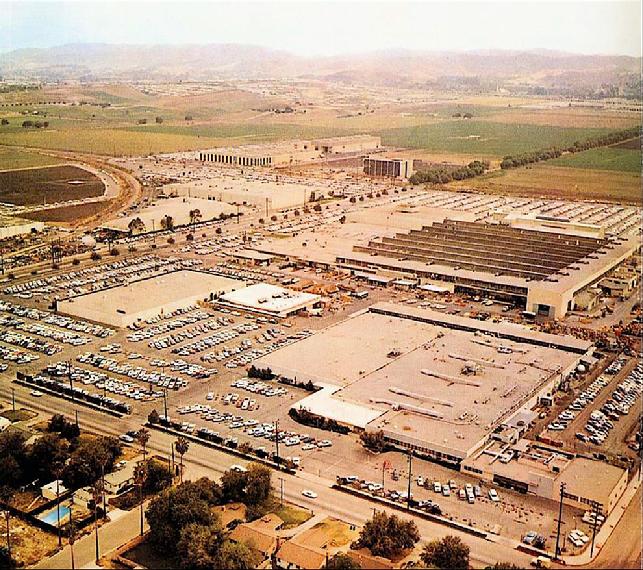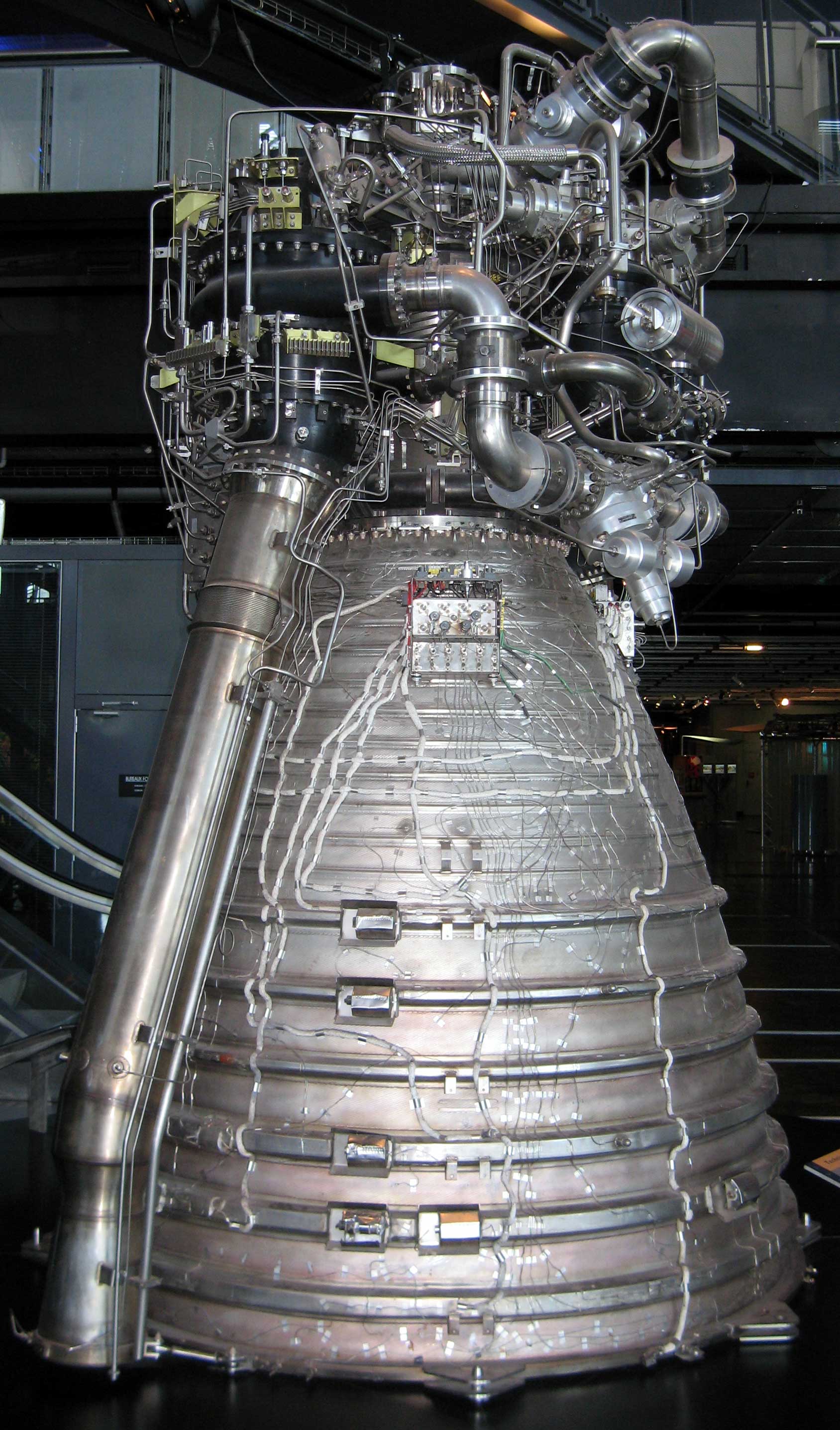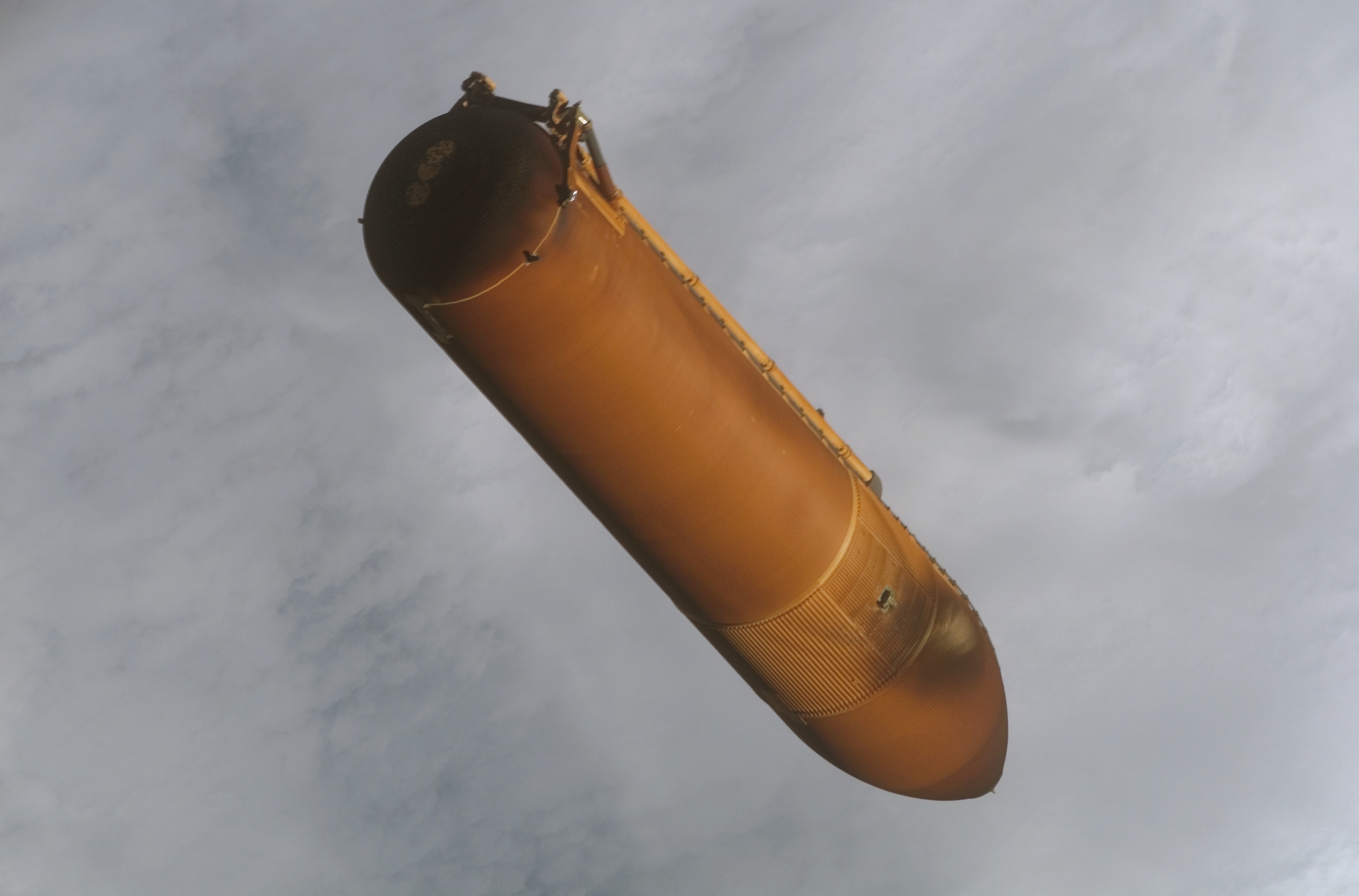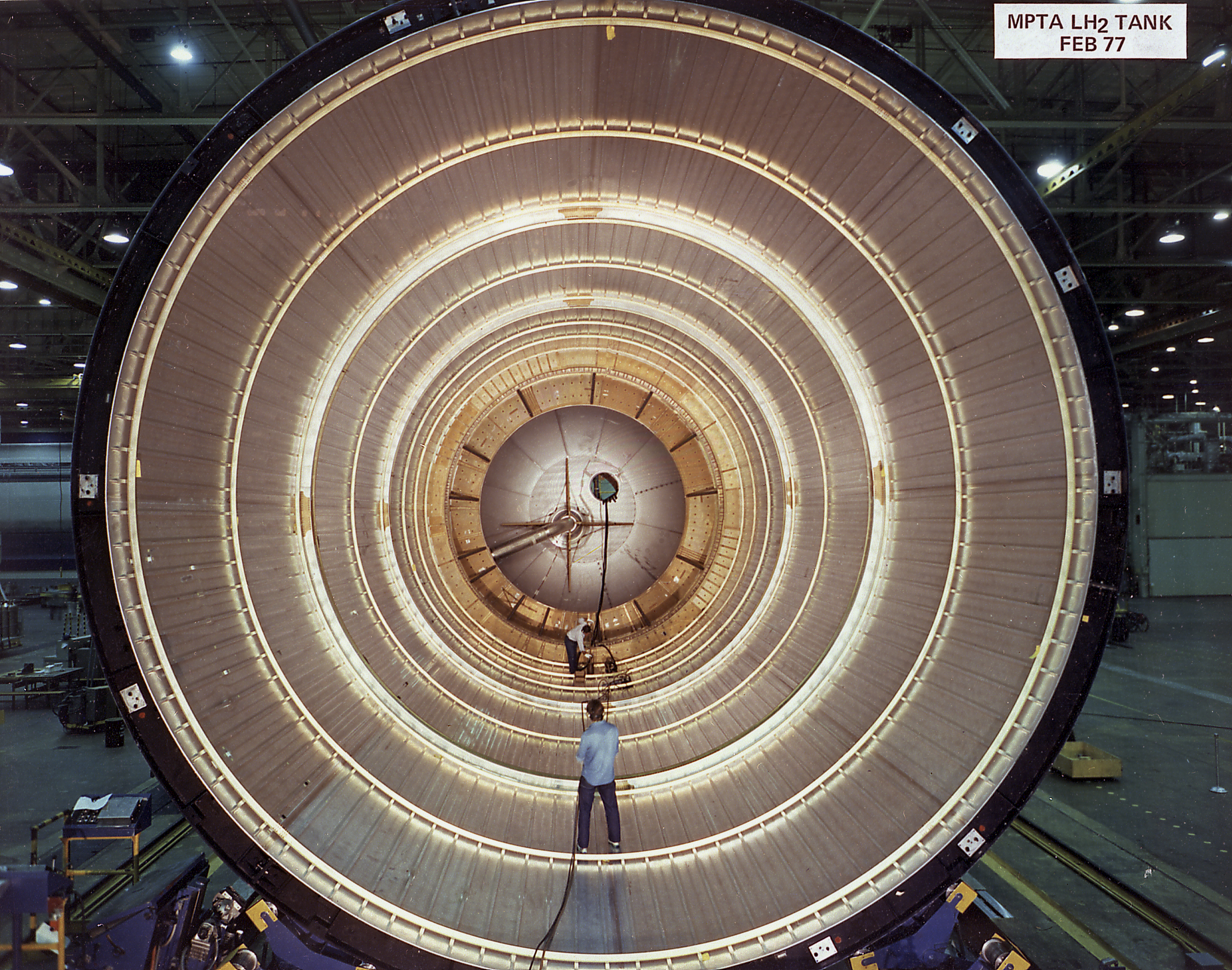|
SSME
The RS-25, also known as the Space Shuttle Main Engine (SSME), is a liquid-fuel cryogenic rocket engine that was used on NASA's Space Shuttle and is used on the Space Launch System. Designed and manufactured in the United States by Rocketdyne (later Pratt & Whitney Rocketdyne and Aerojet Rocketdyne), the RS-25 burns cryogenic (very low temperature) liquid hydrogen and liquid oxygen propellants, with each engine producing thrust at liftoff. Although RS-25 heritage traces back to the 1960s, its concerted development began in the 1970s with the first flight, STS-1, on April 12, 1981. The RS-25 has undergone upgrades over its operational history to improve the engine's thrust, reliability, safety, and maintenance load. The engine produces a specific impulse (''I''sp) of 452 seconds (4.43 kN-sec/kg) in vacuum, or 366 seconds (3.59 kN-sec/kg) at sea level, has a mass of approximately , and is capable of throttling between 67% and 109% of its rated power level in one- ... [...More Info...] [...Related Items...] OR: [Wikipedia] [Google] [Baidu] |
Space Shuttle Solid Rocket Booster
The Space Shuttle Solid Rocket Booster (SRB) was the first solid-propellant rocket to be used for primary propulsion on a vehicle used for human spaceflight. A pair of them provided 85% of the Space Shuttle's thrust at liftoff and for the first two minutes of ascent. After burnout, they were jettisoned, and parachuted into the Atlantic Ocean, where they were recoverable booster, recovered, examined, refurbished, and reusable launch system, reused. The Space Shuttle SRBs were the most powerful solid rocket motors to ever launch humans. The Space Launch System (SLS) SRBs, adapted from the shuttle, surpassed it as the most powerful solid rocket motors ever flown, after the launch of the Artemis 1 mission in 2022. Each Space Shuttle SRB provided a maximum thrust, roughly double the most powerful single-combustion chamber liquid-propellant rocket engine ever flown, the Rocketdyne F-1. With a combined mass of about , they comprised over half the mass of the Shuttle stack at liftoff. ... [...More Info...] [...Related Items...] OR: [Wikipedia] [Google] [Baidu] |
Space Shuttle
The Space Shuttle is a retired, partially reusable launch system, reusable low Earth orbital spacecraft system operated from 1981 to 2011 by the U.S. National Aeronautics and Space Administration (NASA) as part of the Space Shuttle program. Its official program name was the Space Transportation System (STS), taken from the 1969 plan led by U.S. vice president Spiro Agnew for a system of reusable spacecraft where it was the only item funded for development. The first (STS-1) of four orbital test flights occurred in 1981, leading to operational flights (STS-5) beginning in 1982. Five complete Space Shuttle orbiter vehicles were built and flown on a total of 135 missions from 1981 to 2011. They launched from the Kennedy Space Center (KSC) in Florida. Operational missions launched numerous satellites, interplanetary probes, and the Hubble Space Telescope (HST), conducted science experiments in orbit, participated in the Shuttle–Mir program, Shuttle-''Mir'' program with Russia, ... [...More Info...] [...Related Items...] OR: [Wikipedia] [Google] [Baidu] |
NASA
The National Aeronautics and Space Administration (NASA ) is an independent agencies of the United States government, independent agency of the federal government of the United States, US federal government responsible for the United States's civil list of government space agencies, space program, aeronautics research and outer space, space research. National Aeronautics and Space Act, Established in 1958, it succeeded the National Advisory Committee for Aeronautics (NACA) to give the American space development effort a distinct civilian orientation, emphasizing peaceful applications in space science. It has since led most of America's space exploration programs, including Project Mercury, Project Gemini, the 1968–1972 Apollo program missions, the Skylab space station, and the Space Shuttle. Currently, NASA supports the International Space Station (ISS) along with the Commercial Crew Program and oversees the development of the Orion (spacecraft), Orion spacecraft and the Sp ... [...More Info...] [...Related Items...] OR: [Wikipedia] [Google] [Baidu] |
Space Shuttle Orbiter
The Space Shuttle orbiter is the spaceplane component of the Space Shuttle, a partially reusable launch system, reusable orbital spaceflight, orbital spacecraft system that was part of the discontinued Space Shuttle program. Operated from 1981 to 2011 by NASA, the U.S. space agency, this vehicle could carry astronauts and payloads into low Earth orbit, perform in-space operations, then atmospheric entry, re-enter the atmosphere and land as a glider aircraft, glider, returning its crew and any on-board payload to the Earth. Six orbiters were built for flight: ''Space Shuttle Enterprise, Enterprise'', ''Space Shuttle Columbia, Columbia'', ''Space Shuttle Challenger, Challenger'', ''Space Shuttle Discovery, Discovery'', ''Space Shuttle Atlantis, Atlantis'', and ''Space Shuttle Endeavour, Endeavour''. All were built in Palmdale, California, by the Pittsburgh, Pennsylvania-based Rockwell International company's North American Aircraft Operations branch. The first orbiter, ''Enterpris ... [...More Info...] [...Related Items...] OR: [Wikipedia] [Google] [Baidu] |
Specific Impulse
Specific impulse (usually abbreviated ) is a measure of how efficiently a reaction mass engine, such as a rocket engine, rocket using propellant or a jet engine using fuel, generates thrust. In general, this is a ratio of the ''Impulse (physics), impulse'', i.e. change in momentum, ''per mass'' of propellant. This is equivalent to "thrust per massflow". The resulting unit is equivalent to velocity. If the engine expels mass at a constant exhaust velocity v_e then the thrust will be \mathbf = v_e \frac . If we integrate over time to get the total change in momentum, and then divide by the mass, we see that the specific impulse is equal to the exhaust velocity v_e . In practice, the specific impulse is usually lower than the actual physical exhaust velocity inefficiencies in the rocket, and thus corresponds to an "effective" exhaust velocity. That is, the specific impulse I_ in units of velocity *is defined by* : \mathbf = I_ \frac , where \mathbf is the average thrust. ... [...More Info...] [...Related Items...] OR: [Wikipedia] [Google] [Baidu] |
Rocketdyne
Rocketdyne is an American rocket engine design and production company headquartered in Canoga Park, California, Canoga Park, in the western San Fernando Valley of suburban Los Angeles, California, Los Angeles, in southern California. Rocketdyne was founded as a division of North American Aviation in 1955 and was later part of Rockwell International from 1967 until 1996 and Boeing from 1996 to 2005. In 2005, Boeing sold the Rocketdyne division to United Technologies Corporation, becoming Pratt & Whitney Rocketdyne as part of Pratt & Whitney. In 2013, Rocketdyne was sold to GenCorp, GenCorp, Inc., which merged it with Aerojet to form Aerojet Rocketdyne.Marjorie Censer(18 Dec 2022) L3Harris moves to acquire Aerojet Rocketdynefor $4.7 billion, after Lockheed Martin ended its attempt for Rocketdyne in Feb 2022 History After World War II, North American Aviation (NAA) was contracted by the Defense Department to study the German V-2, V-2 missile and adapt its engine to Society of Aut ... [...More Info...] [...Related Items...] OR: [Wikipedia] [Google] [Baidu] |
Cryogenic Rocket Engine
A cryogenic rocket engine is a rocket engine that uses a cryogenic fuel and oxidizer; that is, both its fuel and oxidizer are gases which have been liquefied and are stored at very low temperatures. These highly efficient engines were first flown on the US Atlas-Centaur and were one of the main factors of NASA's success in reaching the Moon by the Saturn V rocket. Rocket engines burning cryogenic propellants remain in use today on high performance upper stages and boosters. Upper stages are numerous. Boosters include ESA's Ariane 6, JAXA's H-II, ISRO's GSLV, LVM3, NASA's Space Launch System. The United States, Russia, India, Japan, France and China are the only countries that have operational cryogenic rocket engines. Cryogenic propellants Rocket engines need high mass flow rates of both oxidizer and fuel to generate useful thrust. Oxygen, the simplest and most common oxidizer, is in the gas phase at standard temperature and pressure, as is hydrogen, the simplest f ... [...More Info...] [...Related Items...] OR: [Wikipedia] [Google] [Baidu] |
Space Shuttle External Tank
The Space Shuttle external tank (ET) was the component of the Space Shuttle launch vehicle that contained the liquid hydrogen fuel and liquid oxygen oxidizer. During lift-off and ascent it supplied the fuel and oxidizer under pressure to the three RS-25 main engines in the orbiter. The ET was jettisoned just over 10 seconds after main engine cut-off (MECO) and it re-entered the Earth's atmosphere. Unlike the Solid Rocket Boosters, external tanks were not re-used. They broke up before impact in the Indian Ocean (or Pacific Ocean in the case of direct-insertion launch trajectories), away from shipping lanes and were not recovered. Overview The ET was the largest element of the Space Shuttle, and when loaded, it was also the heaviest. It consisted of three major components: * the forward liquid oxygen (LOX) tank * an unpressurized intertank that contains most of the electrical components * the aft liquid hydrogen (LH2) tank; this was the largest part, but it was relatively l ... [...More Info...] [...Related Items...] OR: [Wikipedia] [Google] [Baidu] |
Liquid-fuel Rocket
A liquid-propellant rocket or liquid rocket uses a rocket engine burning liquid propellants. (Alternate approaches use gaseous or solid propellants.) Liquids are desirable propellants because they have reasonably high density and their combustion products have high specific impulse (''I''sp). This allows the volume of the propellant tanks to be relatively low. Types Liquid rockets can be monopropellant rockets using a single type of propellant, or bipropellant rockets using two types of propellant. Tripropellant rockets using three types of propellant are rare. Liquid oxidizer propellants are also used in hybrid rockets, with some of the advantages of a solid rocket. Bipropellant liquid rockets use a liquid fuel such as liquid hydrogen or RP-1, and a liquid oxidizer such as liquid oxygen. The engine may be a cryogenic rocket engine, where the fuel and oxidizer, such as hydrogen and oxygen, are gases which have been liquefied at very low temperatures. Most designs of liquid ... [...More Info...] [...Related Items...] OR: [Wikipedia] [Google] [Baidu] |
Aerojet Rocketdyne
Aerojet Rocketdyne is a subsidiary of American Arms industry, defense company L3Harris that manufactures rocket, Hypersonic flight, hypersonic, and electric propulsive systems for space, defense, civil and commercial applications. Aerojet traces its origins to the General Tire and Rubber Company (later renamed GenCorp, Inc. as it diversified) established in 1915, while Rocketdyne was created as a division of North American Aviation in 1955. Aerojet Rocketdyne was formed in 2013 when Aerojet and Pratt & Whitney Rocketdyne were merged, following the latter's acquisition by GenCorp, Inc. from Pratt & Whitney. Aerojet Rocketdyne was acquired by L3Harris in July 2023 for $4.7 billion. History Background: Aerojet Several decades after it began manufacturing rubber products, General Tire & Rubber diversified into broadcasting and aeronautics. In the 1940s, the Aerojet company began experimenting with various rocket designs. For a solid-fuel rocket, they needed binders, and tur ... [...More Info...] [...Related Items...] OR: [Wikipedia] [Google] [Baidu] |
Space Shuttle External Tank
The Space Shuttle external tank (ET) was the component of the Space Shuttle launch vehicle that contained the liquid hydrogen fuel and liquid oxygen oxidizer. During lift-off and ascent it supplied the fuel and oxidizer under pressure to the three RS-25 main engines in the orbiter. The ET was jettisoned just over 10 seconds after main engine cut-off (MECO) and it re-entered the Earth's atmosphere. Unlike the Solid Rocket Boosters, external tanks were not re-used. They broke up before impact in the Indian Ocean (or Pacific Ocean in the case of direct-insertion launch trajectories), away from shipping lanes and were not recovered. Overview The ET was the largest element of the Space Shuttle, and when loaded, it was also the heaviest. It consisted of three major components: * the forward liquid oxygen (LOX) tank * an unpressurized intertank that contains most of the electrical components * the aft liquid hydrogen (LH2) tank; this was the largest part, but it was relatively l ... [...More Info...] [...Related Items...] OR: [Wikipedia] [Google] [Baidu] |








